2017 NISSAN FRONTIER octane
[x] Cancel search: octanePage 428 of 478
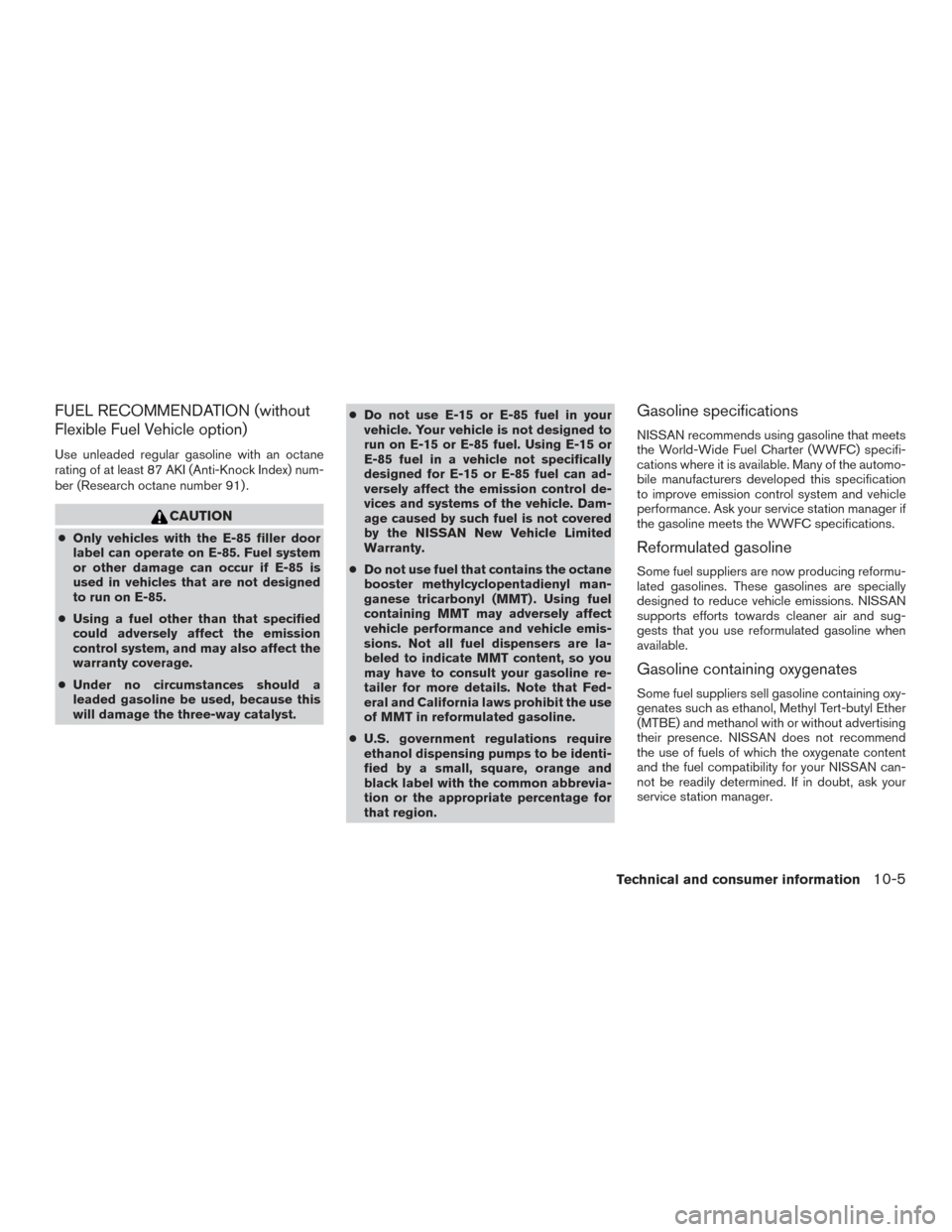
FUEL RECOMMENDATION (without
Flexible Fuel Vehicle option)
Use unleaded regular gasoline with an octane
rating of at least 87 AKI (Anti-Knock Index) num-
ber (Research octane number 91) .
CAUTION
●Only vehicles with the E-85 filler door
label can operate on E-85. Fuel system
or other damage can occur if E-85 is
used in vehicles that are not designed
to run on E-85.
● Using a fuel other than that specified
could adversely affect the emission
control system, and may also affect the
warranty coverage.
● Under no circumstances should a
leaded gasoline be used, because this
will damage the three-way catalyst. ●
Do not use E-15 or E-85 fuel in your
vehicle. Your vehicle is not designed to
run on E-15 or E-85 fuel. Using E-15 or
E-85 fuel in a vehicle not specifically
designed for E-15 or E-85 fuel can ad-
versely affect the emission control de-
vices and systems of the vehicle. Dam-
age caused by such fuel is not covered
by the NISSAN New Vehicle Limited
Warranty.
● Do not use fuel that contains the octane
booster methylcyclopentadienyl man-
ganese tricarbonyl (MMT) . Using fuel
containing MMT may adversely affect
vehicle performance and vehicle emis-
sions. Not all fuel dispensers are la-
beled to indicate MMT content, so you
may have to consult your gasoline re-
tailer for more details. Note that Fed-
eral and California laws prohibit the use
of MMT in reformulated gasoline.
● U.S. government regulations require
ethanol dispensing pumps to be identi-
fied by a small, square, orange and
black label with the common abbrevia-
tion or the appropriate percentage for
that region.
Gasoline specifications
NISSAN recommends using gasoline that meets
the World-Wide Fuel Charter (WWFC) specifi-
cations where it is available. Many of the automo-
bile manufacturers developed this specification
to improve emission control system and vehicle
performance. Ask your service station manager if
the gasoline meets the WWFC specifications.
Reformulated gasoline
Some fuel suppliers are now producing reformu-
lated gasolines. These gasolines are specially
designed to reduce vehicle emissions. NISSAN
supports efforts towards cleaner air and sug-
gests that you use reformulated gasoline when
available.
Gasoline containing oxygenates
Some fuel suppliers sell gasoline containing oxy-
genates such as ethanol, Methyl Tert-butyl Ether
(MTBE) and methanol with or without advertising
their presence. NISSAN does not recommend
the use of fuels of which the oxygenate content
and the fuel compatibility for your NISSAN can-
not be readily determined. If in doubt, ask your
service station manager.
Technical and consumer information10-5
Page 429 of 478
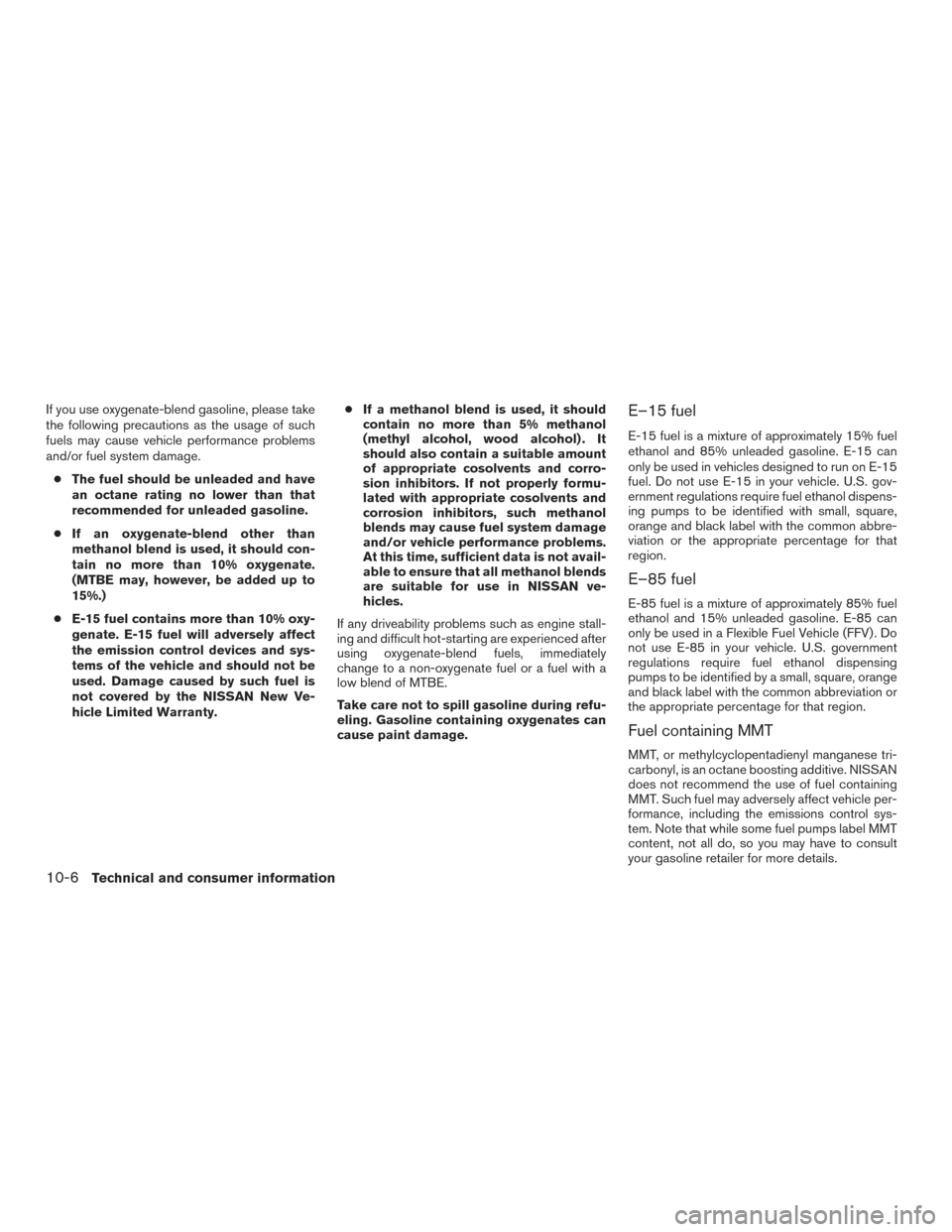
If you use oxygenate-blend gasoline, please take
the following precautions as the usage of such
fuels may cause vehicle performance problems
and/or fuel system damage.● The fuel should be unleaded and have
an octane rating no lower than that
recommended for unleaded gasoline.
● If an oxygenate-blend other than
methanol blend is used, it should con-
tain no more than 10% oxygenate.
(MTBE may, however, be added up to
15%.)
● E-15 fuel contains more than 10% oxy-
genate. E-15 fuel will adversely affect
the emission control devices and sys-
tems of the vehicle and should not be
used. Damage caused by such fuel is
not covered by the NISSAN New Ve-
hicle Limited Warranty. ●
If a methanol blend is used, it should
contain no more than 5% methanol
(methyl alcohol, wood alcohol) . It
should also contain a suitable amount
of appropriate cosolvents and corro-
sion inhibitors. If not properly formu-
lated with appropriate cosolvents and
corrosion inhibitors, such methanol
blends may cause fuel system damage
and/or vehicle performance problems.
At this time, sufficient data is not avail-
able to ensure that all methanol blends
are suitable for use in NISSAN ve-
hicles.
If any driveability problems such as engine stall-
ing and difficult hot-starting are experienced after
using oxygenate-blend fuels, immediately
change to a non-oxygenate fuel or a fuel with a
low blend of MTBE.
Take care not to spill gasoline during refu-
eling. Gasoline containing oxygenates can
cause paint damage.E–15 fuel
E-15 fuel is a mixture of approximately 15% fuel
ethanol and 85% unleaded gasoline. E-15 can
only be used in vehicles designed to run on E-15
fuel. Do not use E-15 in your vehicle. U.S. gov-
ernment regulations require fuel ethanol dispens-
ing pumps to be identified with small, square,
orange and black label with the common abbre-
viation or the appropriate percentage for that
region.
E–85 fuel
E-85 fuel is a mixture of approximately 85% fuel
ethanol and 15% unleaded gasoline. E-85 can
only be used in a Flexible Fuel Vehicle (FFV) . Do
not use E-85 in your vehicle. U.S. government
regulations require fuel ethanol dispensing
pumps to be identified by a small, square, orange
and black label with the common abbreviation or
the appropriate percentage for that region.
Fuel containing MMT
MMT, or methylcyclopentadienyl manganese tri-
carbonyl, is an octane boosting additive. NISSAN
does not recommend the use of fuel containing
MMT. Such fuel may adversely affect vehicle per-
formance, including the emissions control sys-
tem. Note that while some fuel pumps label MMT
content, not all do, so you may have to consult
your gasoline retailer for more details.
10-6Technical and consumer information
Page 430 of 478
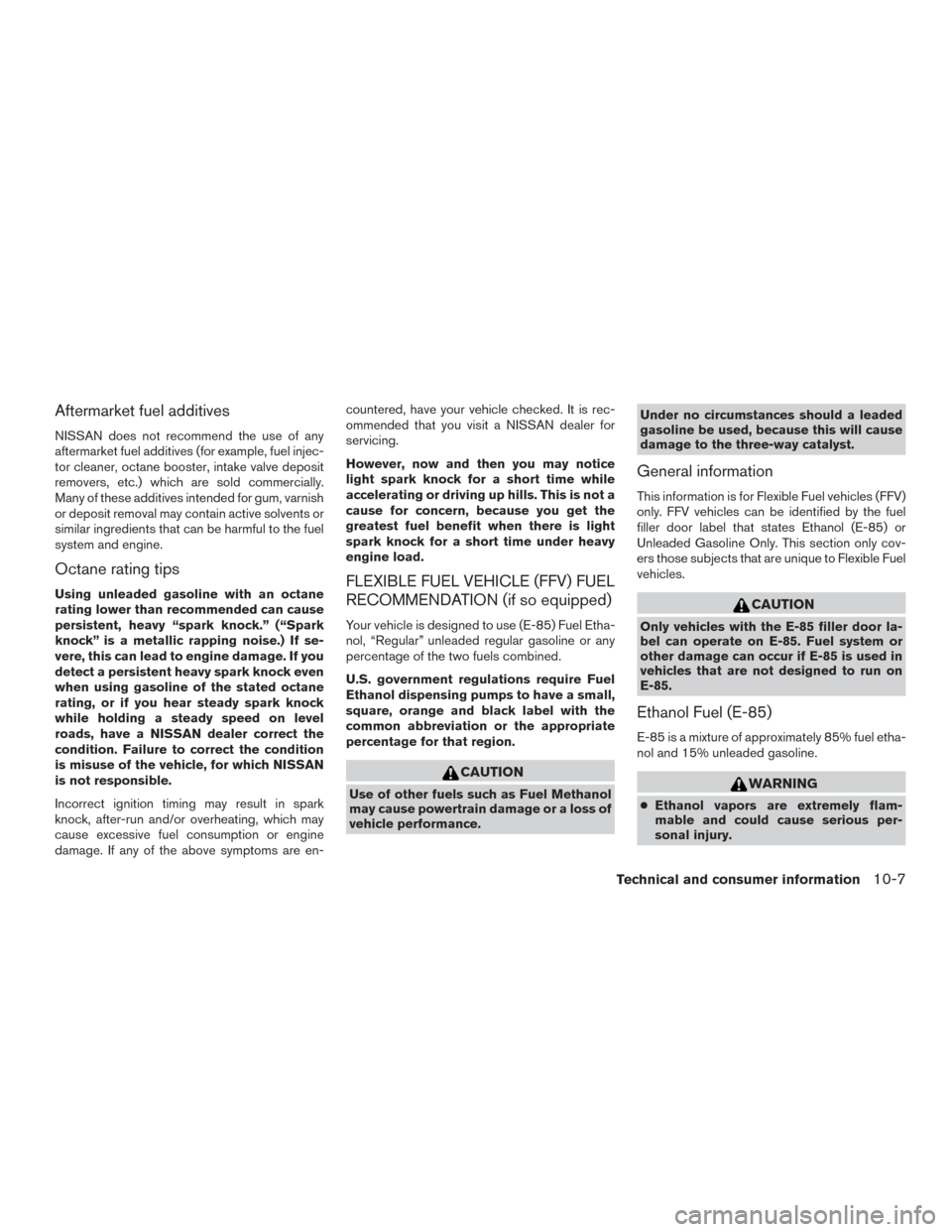
Aftermarket fuel additives
NISSAN does not recommend the use of any
aftermarket fuel additives (for example, fuel injec-
tor cleaner, octane booster, intake valve deposit
removers, etc.) which are sold commercially.
Many of these additives intended for gum, varnish
or deposit removal may contain active solvents or
similar ingredients that can be harmful to the fuel
system and engine.
Octane rating tips
Using unleaded gasoline with an octane
rating lower than recommended can cause
persistent, heavy “spark knock.” (“Spark
knock” is a metallic rapping noise.) If se-
vere, this can lead to engine damage. If you
detect a persistent heavy spark knock even
when using gasoline of the stated octane
rating, or if you hear steady spark knock
while holding a steady speed on level
roads, have a NISSAN dealer correct the
condition. Failure to correct the condition
is misuse of the vehicle, for which NISSAN
is not responsible.
Incorrect ignition timing may result in spark
knock, after-run and/or overheating, which may
cause excessive fuel consumption or engine
damage. If any of the above symptoms are en-countered, have your vehicle checked. It is rec-
ommended that you visit a NISSAN dealer for
servicing.
However, now and then you may notice
light spark knock for a short time while
accelerating or driving up hills. This is not a
cause for concern, because you get the
greatest fuel benefit when there is light
spark knock for a short time under heavy
engine load.FLEXIBLE FUEL VEHICLE (FFV) FUEL
RECOMMENDATION (if so equipped)
Your vehicle is designed to use (E-85) Fuel Etha-
nol, “Regular” unleaded regular gasoline or any
percentage of the two fuels combined.
U.S. government regulations require Fuel
Ethanol dispensing pumps to have a small,
square, orange and black label with the
common abbreviation or the appropriate
percentage for that region.
CAUTION
Use of other fuels such as Fuel Methanol
may cause powertrain damage or a loss of
vehicle performance.
Under no circumstances should a leaded
gasoline be used, because this will cause
damage to the three-way catalyst.
General information
This information is for Flexible Fuel vehicles (FFV)
only. FFV vehicles can be identified by the fuel
filler door label that states Ethanol (E-85) or
Unleaded Gasoline Only. This section only cov-
ers those subjects that are unique to Flexible Fuel
vehicles.
CAUTION
Only vehicles with the E-85 filler door la-
bel can operate on E-85. Fuel system or
other damage can occur if E-85 is used in
vehicles that are not designed to run on
E-85.
Ethanol Fuel (E-85)
E-85 is a mixture of approximately 85% fuel etha-
nol and 15% unleaded gasoline.
WARNING
●
Ethanol vapors are extremely flam-
mable and could cause serious per-
sonal injury.
Technical and consumer information10-7
Page 431 of 478
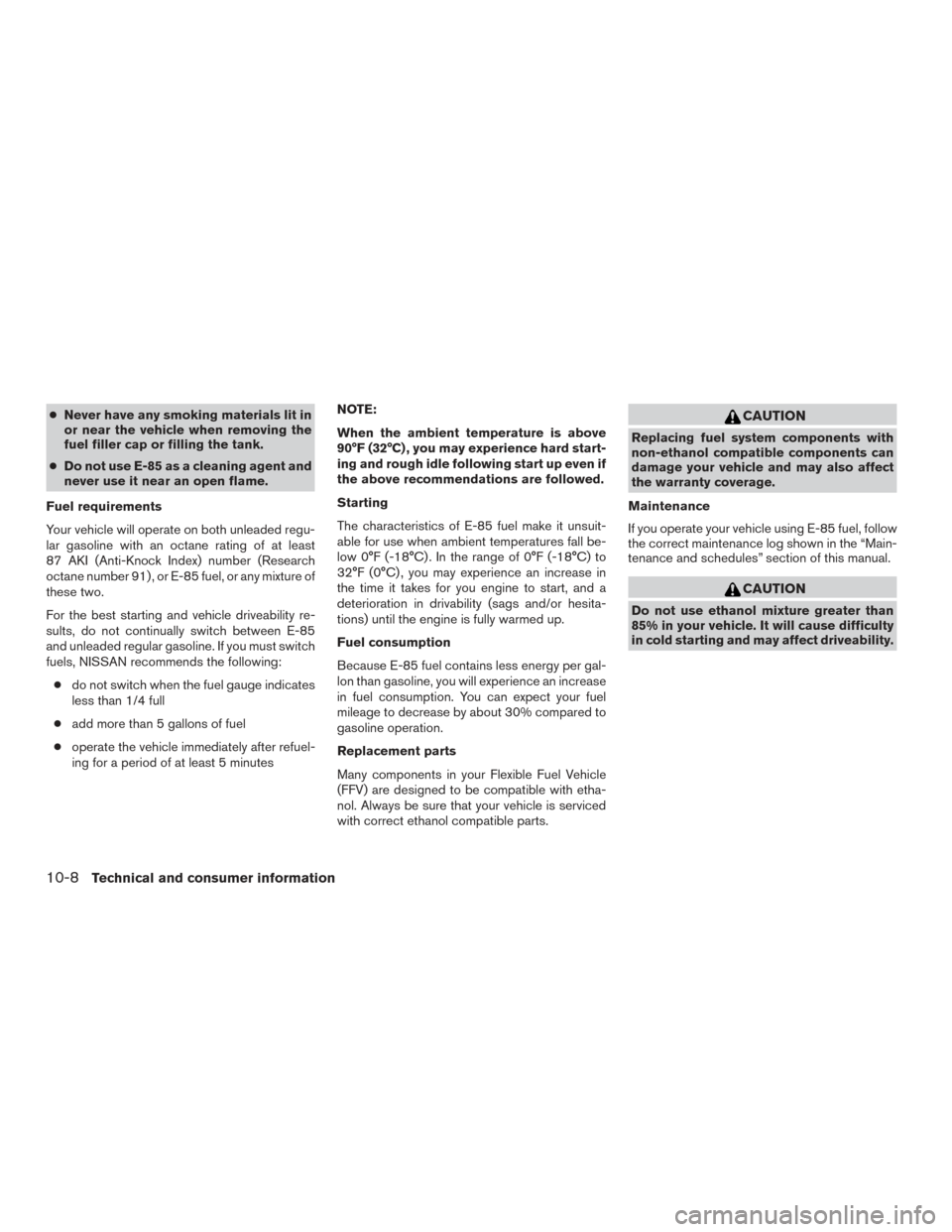
●Never have any smoking materials lit in
or near the vehicle when removing the
fuel filler cap or filling the tank.
● Do not use E-85 as a cleaning agent and
never use it near an open flame.
Fuel requirements
Your vehicle will operate on both unleaded regu-
lar gasoline with an octane rating of at least
87 AKI (Anti-Knock Index) number (Research
octane number 91) , or E-85 fuel, or any mixture of
these two.
For the best starting and vehicle driveability re-
sults, do not continually switch between E-85
and unleaded regular gasoline. If you must switch
fuels, NISSAN recommends the following: ● do not switch when the fuel gauge indicates
less than 1/4 full
● add more than 5 gallons of fuel
● operate the vehicle immediately after refuel-
ing for a period of at least 5 minutes NOTE:
When the ambient temperature is above
90°F (32°C) , you may experience hard start-
ing and rough idle following start up even if
the above recommendations are followed.
Starting
The characteristics of E-85 fuel make it unsuit-
able for use when ambient temperatures fall be-
low 0°F (-18°C) . In the range of 0°F (-18°C) to
32°F (0°C) , you may experience an increase in
the time it takes for you engine to start, and a
deterioration in drivability (sags and/or hesita-
tions) until the engine is fully warmed up.
Fuel consumption
Because E-85 fuel contains less energy per gal-
lon than gasoline, you will experience an increase
in fuel consumption. You can expect your fuel
mileage to decrease by about 30% compared to
gasoline operation.
Replacement parts
Many components in your Flexible Fuel Vehicle
(FFV) are designed to be compatible with etha-
nol. Always be sure that your vehicle is serviced
with correct ethanol compatible parts.CAUTION
Replacing fuel system components with
non-ethanol compatible components can
damage your vehicle and may also affect
the warranty coverage.
Maintenance
If you operate your vehicle using E-85 fuel, follow
the correct maintenance log shown in the “Main-
tenance and schedules” section of this manual.
CAUTION
Do not use ethanol mixture greater than
85% in your vehicle. It will cause difficulty
in cold starting and may affect driveability.
10-8Technical and consumer information
Page 436 of 478
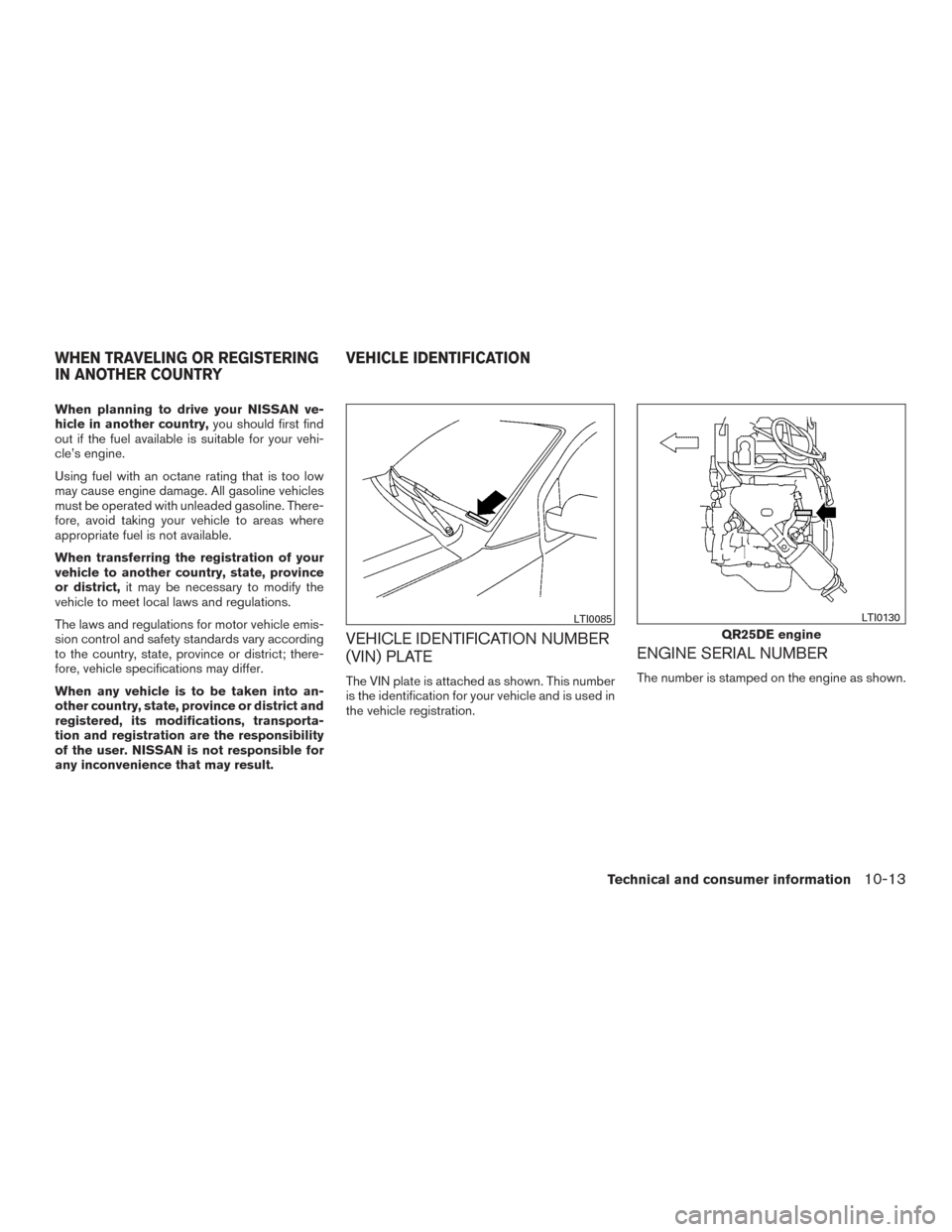
When planning to drive your NISSAN ve-
hicle in another country,you should first find
out if the fuel available is suitable for your vehi-
cle’s engine.
Using fuel with an octane rating that is too low
may cause engine damage. All gasoline vehicles
must be operated with unleaded gasoline. There-
fore, avoid taking your vehicle to areas where
appropriate fuel is not available.
When transferring the registration of your
vehicle to another country, state, province
or district, it may be necessary to modify the
vehicle to meet local laws and regulations.
The laws and regulations for motor vehicle emis-
sion control and safety standards vary according
to the country, state, province or district; there-
fore, vehicle specifications may differ.
When any vehicle is to be taken into an-
other country, state, province or district and
registered, its modifications, transporta-
tion and registration are the responsibility
of the user. NISSAN is not responsible for
any inconvenience that may result.
VEHICLE IDENTIFICATION NUMBER
(VIN) PLATE
The VIN plate is attached as shown. This number
is the identification for your vehicle and is used in
the vehicle registration.
ENGINE SERIAL NUMBER
The number is stamped on the engine as shown.
LTI0085
QR25DE engine
LTI0130
WHEN TRAVELING OR REGISTERING
IN ANOTHER COUNTRY VEHICLE IDENTIFICATION
Technical and consumer information10-13
Page 470 of 478
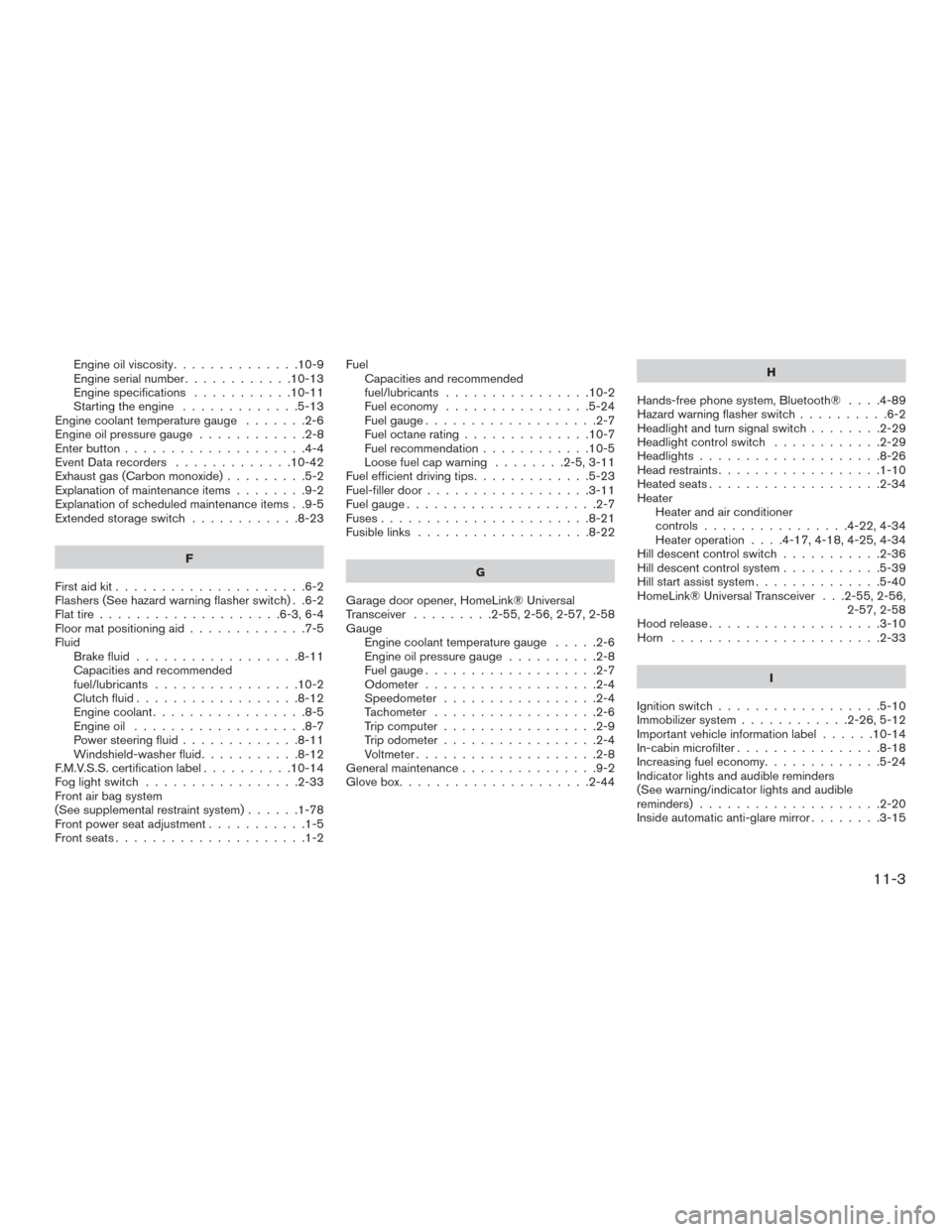
Engine oil viscosity..............10-9
Engine serial number ............10-13
Engine specifications ...........10-11
Starting the engine .............5-13
Engine coolant temperature gauge .......2-6
Engineoilpressuregauge............2-8
Enterbutton....................4-4
Event Data recorders .............10-42
Exhaust gas (Carbon monoxide) .........5-2
Explanation of maintenance items ........9-2
Explanation of scheduled maintenance items . .9-5
Extendedstorageswitch ............8-23
F
First aid kit .....................6-2
Flashers (See hazard warning flasher switch) . .6-2
Flat tire ....................6-3,6-4
Floor mat positioning aid .............7-5
Fluid Brake fluid ..................8-11
Capacities and recommended
fuel/lubricants ................10-2
Clutchfluid..................8-12
Engine coolant .................8-5
Engine oil ...................8-7
Power steering fluid .............8-11
Windshield-washerfluid...........8-12
F.M.V.S.S. certification label ..........10-14
Foglightswitch .................2-33
Front air bag system
(See supplemental restraint system) ......1-78
Front power seat adjustment ...........1-5
Frontseats.....................1-2 Fuel
Capacities and recommended
fuel/lubricants ................10-2
Fuel economy ................5-24
Fuel gauge ...................2-7
Fuel octane rating ..............10-7
Fuel recommendation ............10-5
Loose fuel cap warning ........2-5,3-11
Fuel efficient driving tips .............5-23
Fuel-filler door ..................3-11
Fuelgauge.....................2-7
Fuses.......................8-21
Fusiblelinks ...................8-22
G
Garage door opener, HomeLink® Universal
Transceiver .........2-55,2-56,2-57,2-58
Gauge Engine coolant temperature gauge .....2-6
Engine oil pressure gauge ..........2-8
Fuel gauge ...................2-7
Odometer ...................2-4
Speedometer .................2-4
Tachometer ..................2-6
Trip computer .................2-9
Trip odometer .................2-4
Voltmeter....................2-8
General maintenance ...............9-2
Glovebox.....................2-44 H
Hands-free phone system, Bluetooth® ....4-89
Hazard warning flasher switch ..........6-2
Headlightandturnsignalswitch........2-29
Headlightcontrolswitch ............2-29
Headlights....................8-26
Head restraints ..................1-10
Heated seats ...................2-34
Heater Heater and air conditioner
controls ................4-22,4-34
Heater operation ....4-17,4-18,4-25,4-34
Hill descent control switch ...........2-36
Hill descent
control system ...........5-39
Hill start assist system ..............5-40
HomeLink® Universal Transceiver . . .2-55, 2-56, 2-57, 2-58
Hoodrelease...................3-10
Horn .......................2-33
I
Ignition switch ..................5-10
Immobilizer system ............2-26,5-12
Important vehicle information label ......10-14
In-cabin microfilter ................8-18
Increasing fuel economy .............5-24
Indicator lights and audible reminders
(See warning/indicator lights and audible
reminders)....................2-20
Inside automatic anti-glare mirror ........3-15
11-3
Page 472 of 478
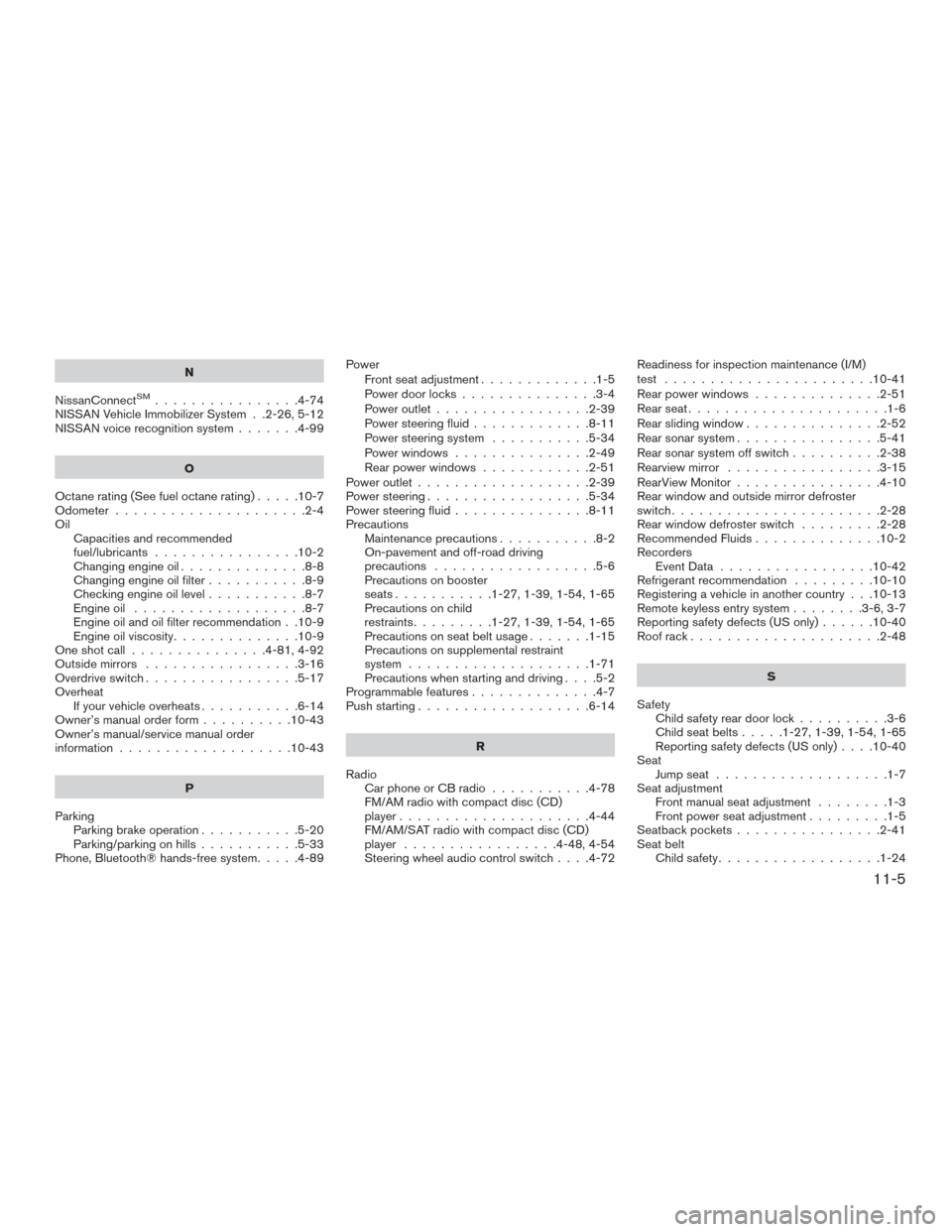
N
NissanConnect
SM................4-74
NISSAN Vehicle Immobilizer System . .2-26, 5-12
NISSAN voice recognition system .......4-99
O
Octanerating(Seefueloctanerating).....10-7
Odometer .....................2-4
Oil Capacities and recommended
fuel/lubricants ................10-2
Changing engine oil ..............8-8
Changing engine oil filter ...........8-9
Checking engine oil level ...........8-7
Engine oil ...................8-7
Engine oil and oil filter recommendation . .10-9
Engine oil viscosity ..............10-9
Oneshotcall...............4-81,4-92
Outside mirrors .................3-16
Overdrive switch .................5-17
Overheat Ifyourvehicleoverheats...........6-14
Owner’s manual order form ..........10-43
Owner’s manual/service manual order
information ...................10-43
P
Parking Parking brake operation ...........5-20
Parking/parking on hills ...........5-33
Phone, Bluetooth® hands-free system .....4-89Power
Front seat adjustment .............1-5
Power door locks ...............3-4
Power outlet .................2-39
Power steering fluid .............8-11
Power steering system ...........5-34
Power windows ...............2-49
Rear power windows ............2-51
Power outlet ...................2-39
Power steering ..................5-34
Power steering fluid ...............8-11
Precautions Maintenance precautions ...........8-2
On-pavement and off-road driving
precautions ..................5-6
Precautions on booster
seats...........1-27,1-39,1-54,1-65
Precautions on child
restraints .........1-27,1-39,1-54,1-65
Precautions on seat belt usage .......1-15
Precautions on supplemental restraint
system ....................1-71
Precautions when starting and driving ....5-2
Programmablefeatures..............4-7
Push starting ...................6-14
R
Radio Car phone or CB radio ...........4-78
FM/AM radio with compact disc (CD)
player .....................4-44
FM/AM/SAT radio with compact disc (CD)
player .................4-48,4-54
Steering wheel audio control switch ....4-72Readiness for inspection maintenance (I/M)
test
.......................10-41
Rear power windows ..............2-51
Rearseat......................1-6
Rear sliding window ...............2-52
Rear sonar system ................5-41
Rear sonar system off switch ..........2-38
Rearview mirror .................3-15
RearView Monitor ................4-10
Rear window and outside mirror defroster
switch.......................2-28
Rear window defroster switch .........
2
-28
Recommended Fluids ..............10-2
Recorders EventData .................10-42
Refrigerant recommendation .........10-10
Registering a vehicle in another country . . .10-13
Remote keyless entry system ........3-6,3-7
Reporting safety defects (US only) ......10-40
Roof rack .....................2-48
S
Safety Child safety rear door lock ..........3-6
Child seat belts .....1-27,1-39,1-54,1-65
Reporting safety defects (US only) ....10-40
Seat Jumpseat ...................1-7
Seat adjustment Front manual seat adjustment ........1-3
Front power seat adjustment .........1-5
Seatbackpockets................2-41
Seat belt Child safety ..................1-24
11-5
Page 476 of 478
![NISSAN FRONTIER 2017 D23 / 3.G Owners Manual FUEL RECOMMENDATION (without
Flexible Fuel Vehicle [FFV] option):
Use unleaded regular gasoline with an octane
rating of at least 87 AKI (Anti-Knock Index) num-
ber (Research octane number 91) .
CAUTI NISSAN FRONTIER 2017 D23 / 3.G Owners Manual FUEL RECOMMENDATION (without
Flexible Fuel Vehicle [FFV] option):
Use unleaded regular gasoline with an octane
rating of at least 87 AKI (Anti-Knock Index) num-
ber (Research octane number 91) .
CAUTI](/manual-img/5/521/w960_521-475.png)
FUEL RECOMMENDATION (without
Flexible Fuel Vehicle [FFV] option):
Use unleaded regular gasoline with an octane
rating of at least 87 AKI (Anti-Knock Index) num-
ber (Research octane number 91) .
CAUTION
●Only vehicles with the E-85 filler door
label can operate on E-85. Fuel system
or other damage can occur if E-85 is
used in vehicles that are not designed
to run on E-85.
● Using a fuel other than that specified
could adversely affect the emission
control system, and may also affect the
warranty coverage.
● Under no circumstances should a
leaded gasoline be used, because this
will damage the three-way catalyst. ●
Do not use E-15 or E-85 fuel in your
vehicle. Your vehicle is not designed to
run on E-15 or E-85 fuel. Using E-15 or
E-85 fuel in a vehicle not specifically
designed for E-15 or E-85 fuel can ad-
versely affect the emission control de-
vices and systems of the vehicle. Dam-
age caused by such fuel is not covered
by the NISSAN New Vehicle Limited
Warranty.
● Do not use fuel that contains the octane
booster methylcyclopentadienyl man-
ganese tricarbonyl (MMT) . Using fuel
containing MMT may adversely affect
vehicle performance and vehicle emis-
sions. Not all fuel dispensers are la-
beled to indicate MMT content, so you
may have to consult your gasoline re-
tailer for more details. Note that Fed-
eral and California laws prohibit the use
of MMT in reformulated gasoline.
● U.S. government regulations require
ethanol dispensing pumps to be identi-
fied by a small, square, orange and
black label with the common abbrevia-
tion or the appropriate percentage for
that region. For additional information, refer to “Recom-
mended fluids/lubricants and capacities” in the
“Technical and consumer information” section of
this manual.
FLEXIBLE FUEL VEHICLE (FFV)
FUEL RECOMMENDATION (if so
equipped):
If your vehicle is equipped as a Flexible Fuel
vehicle (FFV) your vehicle is designed to use
(E-85) Fuel Ethanol, “Regular” unleaded regular
gasoline or any percentage of the two fuels com-
bined.
CAUTION
●
Using a fuel other than that specified
could adversely affect the emission
control system, and may also affect the
warranty coverage.
● Under no circumstances should a
leaded gasoline be used, because this
will damage the three-way catalyst.
For additional information, refer to “Recom-
mended fluids/lubricants and capacities” in the
“Technical and consumer information” section of
this manual.
GAS STATION INFORMATION